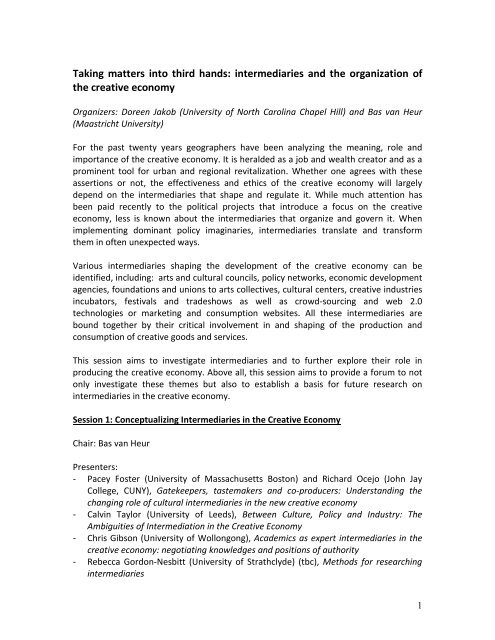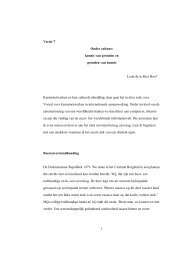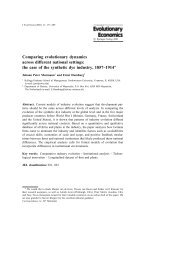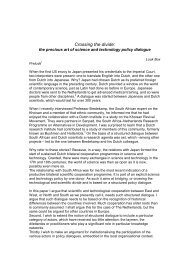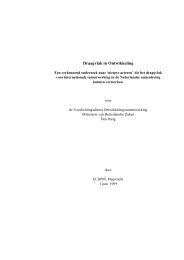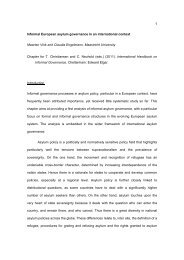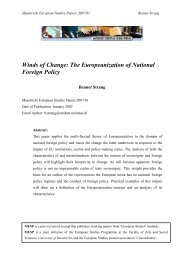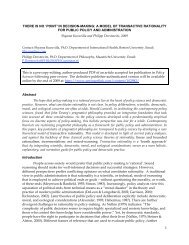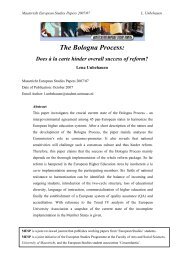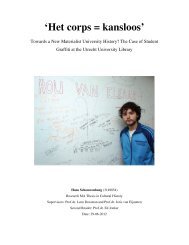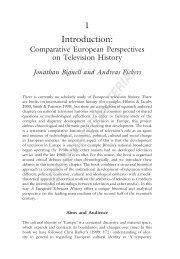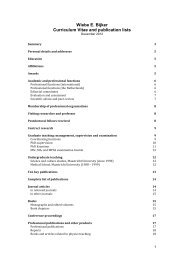Taking matters into third hands: intermediaries and the organization ...
Taking matters into third hands: intermediaries and the organization ...
Taking matters into third hands: intermediaries and the organization ...
Create successful ePaper yourself
Turn your PDF publications into a flip-book with our unique Google optimized e-Paper software.
<strong>Taking</strong> <strong>matters</strong> <strong>into</strong> <strong>third</strong> <strong>h<strong>and</strong>s</strong>: <strong>intermediaries</strong> <strong>and</strong> <strong>the</strong> <strong>organization</strong> of<br />
<strong>the</strong> creative economy<br />
Organizers: Doreen Jakob (University of North Carolina Chapel Hill) <strong>and</strong> Bas van Heur<br />
(Maastricht University)<br />
For <strong>the</strong> past twenty years geographers have been analyzing <strong>the</strong> meaning, role <strong>and</strong><br />
importance of <strong>the</strong> creative economy. It is heralded as a job <strong>and</strong> wealth creator <strong>and</strong> as a<br />
prominent tool for urban <strong>and</strong> regional revitalization. Whe<strong>the</strong>r one agrees with <strong>the</strong>se<br />
assertions or not, <strong>the</strong> effectiveness <strong>and</strong> ethics of <strong>the</strong> creative economy will largely<br />
depend on <strong>the</strong> <strong>intermediaries</strong> that shape <strong>and</strong> regulate it. While much attention has<br />
been paid recently to <strong>the</strong> political projects that introduce a focus on <strong>the</strong> creative<br />
economy, less is known about <strong>the</strong> <strong>intermediaries</strong> that organize <strong>and</strong> govern it. When<br />
implementing dominant policy imaginaries, <strong>intermediaries</strong> translate <strong>and</strong> transform<br />
<strong>the</strong>m in often unexpected ways.<br />
Various <strong>intermediaries</strong> shaping <strong>the</strong> development of <strong>the</strong> creative economy can be<br />
identified, including: arts <strong>and</strong> cultural councils, policy networks, economic development<br />
agencies, foundations <strong>and</strong> unions to arts collectives, cultural centers, creative industries<br />
incubators, festivals <strong>and</strong> tradeshows as well as crowd-sourcing <strong>and</strong> web 2.0<br />
technologies or marketing <strong>and</strong> consumption websites. All <strong>the</strong>se <strong>intermediaries</strong> are<br />
bound toge<strong>the</strong>r by <strong>the</strong>ir critical involvement in <strong>and</strong> shaping of <strong>the</strong> production <strong>and</strong><br />
consumption of creative goods <strong>and</strong> services.<br />
This session aims to investigate <strong>intermediaries</strong> <strong>and</strong> to fur<strong>the</strong>r explore <strong>the</strong>ir role in<br />
producing <strong>the</strong> creative economy. Above all, this session aims to provide a forum to not<br />
only investigate <strong>the</strong>se <strong>the</strong>mes but also to establish a basis for future research on<br />
<strong>intermediaries</strong> in <strong>the</strong> creative economy.<br />
Session 1: Conceptualizing Intermediaries in <strong>the</strong> Creative Economy<br />
Chair: Bas van Heur<br />
Presenters:<br />
- Pacey Foster (University of Massachusetts Boston) <strong>and</strong> Richard Ocejo (John Jay<br />
College, CUNY), Gatekeepers, tastemakers <strong>and</strong> co-producers: Underst<strong>and</strong>ing <strong>the</strong><br />
changing role of cultural <strong>intermediaries</strong> in <strong>the</strong> new creative economy<br />
- Calvin Taylor (University of Leeds), Between Culture, Policy <strong>and</strong> Industry: The<br />
Ambiguities of Intermediation in <strong>the</strong> Creative Economy<br />
- Chris Gibson (University of Wollongong), Academics as expert <strong>intermediaries</strong> in <strong>the</strong><br />
creative economy: negotiating knowledges <strong>and</strong> positions of authority<br />
- Rebecca Gordon-Nesbitt (University of Strathclyde) (tbc), Methods for researching<br />
<strong>intermediaries</strong><br />
1
- Tone Haraldsen (Institute of Transport Economics) <strong>and</strong> Atle Hauge (Eastern Norway<br />
Research Institute), Consumerpower in <strong>the</strong> experience economy<br />
Session 2: Urban Hierarchies<br />
Chair: Doreen Jakob<br />
Presenters:<br />
- Elizabeth Currid-Halkett (University of Sou<strong>the</strong>rn California) <strong>and</strong> Allen J Scott (UCLA),<br />
The Geography of Celebrity <strong>and</strong> Glamour: Economy, Culture <strong>and</strong> Desire in <strong>the</strong> City<br />
- Robert Kloosterman (AISSR, University of Amsterdam) <strong>and</strong> Mariangela Lavanga<br />
(AISSR, University of Amsterdam), Global Urban Hierarchies <strong>and</strong> Cultural Industries.<br />
A Comparison of <strong>the</strong> Development of Cultural Industries in Amsterdam, Genoa,<br />
London, Los Angeles, Milan, New York, <strong>and</strong> Zurich, 1900-2000<br />
- Dominic J. Power (Uppsala University) <strong>and</strong> Mark Lorenzen (Copenhagen Business<br />
School), Trusty Places <strong>and</strong> Quality-Based Competition: The Geographies of Cultural-<br />
Product Origins <strong>and</strong> Outlets<br />
- Bas Van Heur (Maastricht University), Mapping <strong>the</strong> Geographies of Policy Change:<br />
Creative Industries in <strong>the</strong> Ne<strong>the</strong>rl<strong>and</strong>s<br />
Session 3: Government Policies <strong>and</strong> Strategies<br />
Chair: Benjamin Schultz<br />
Presenters:<br />
- Jules Channer (University of Exeter), In search of solid ground: state <strong>intermediaries</strong><br />
<strong>and</strong> <strong>the</strong> creative industries<br />
- Galina Gornostaeva (University of Greenwich) <strong>and</strong> Noel Campbell (University of<br />
Greenwich), Publicly funded <strong>intermediaries</strong> in <strong>the</strong> British film industry <strong>and</strong> <strong>the</strong><br />
paradox of embeddedness: <strong>the</strong> example of <strong>the</strong> Film Council<br />
- Cheryl Hughes, Study of Local Arts Agencies: A Case for Local Government Support of<br />
<strong>the</strong> Arts<br />
- Justin O'Connor (Queensl<strong>and</strong> University of Technology) <strong>and</strong> Xin Gu (Queensl<strong>and</strong><br />
University of Technology), designing creative clusters in China - a western model?<br />
Session 4: Place <strong>and</strong> Path Dependencies<br />
Chair: Galina Gornostaeva<br />
Presenters:<br />
- Carl Grodach (University of Texas Arlington), Cultural Planning in a Creative City: The<br />
Role of Context, Institutions, <strong>and</strong> Process<br />
- Norma Rantisi (Concordia University) <strong>and</strong> Deborah Leslie (University of Toronto), The<br />
Role of Localized Institutions in 'Path Creation': <strong>the</strong> Case of <strong>the</strong> Cirque du Soleil<br />
2
- Naomi Bartz (University of Chicago), The Emergence of a Neighborhood-Level<br />
Creative Economy <strong>and</strong> <strong>the</strong> Various Intermediaries that Shape it: Divergent Models,<br />
Uneasy Alliances, <strong>and</strong> Unexpected Tensions across Stakeholder Groups in a Pluralistic<br />
Political Arena<br />
- Özge Öner (Jönköping International Business School), Location of Recreation: A<br />
probability presence approach<br />
Session 5: Inside/Outside <strong>the</strong> Creative Economy I<br />
Chair: Carl Grodach<br />
Presenters:<br />
- Tara Vinodrai (University of Waterloo), Constructing creativity: Design,<br />
<strong>intermediaries</strong> <strong>and</strong> institutions in Canada <strong>and</strong> Denmark<br />
- Benjamin Shultz (University of Tennessee), The Alternative Art Worlds of <strong>the</strong> Indie<br />
<strong>and</strong> DiY Movements<br />
- Karenjit Clare (University of Oxford), Reproducing Gender Divisions: The Role of<br />
Headhunters in <strong>the</strong> Creative Economy<br />
- Jeffrey S. Boggs (Brock University), The evolution of <strong>intermediaries</strong> in Canada's book<br />
trade<br />
Session 6: Inside/Outside <strong>the</strong> Creative Economy II<br />
Chair: Karenjit Clare<br />
Presenters:<br />
- Doreen Jakob (University of North Carolina Chapel Hill), Arts practices in Flux: new<br />
artist collectives for a creative economy<br />
- Ca<strong>the</strong>rine Morel (Kingston University), The role of art fairs in <strong>the</strong> contemporary art<br />
galleries' acquisition <strong>and</strong> management of legitimacy<br />
- Ned Rossiter (University of Nottingham Ningbo), Logistics <strong>and</strong> Informal Circuits of<br />
Labour in China<br />
- Harvey Molotch (New York University), Public Restrooms as Taboo Scenarios<br />
Session 7: The Future of Creative Economy Research<br />
Chair: Bas van Heur <strong>and</strong> Doreen Jakob<br />
Panelists:<br />
- Steve Millington<br />
- Deborah Leslie<br />
- Justin O'Connor<br />
- Tara Vinodrai<br />
- Graeme Evans<br />
3
Submitted Abstracts<br />
Session 1: Conceptualizing Intermediaries in <strong>the</strong> Creative Economy<br />
Gatekeepers, tastemakers <strong>and</strong> co-producers: Underst<strong>and</strong>ing <strong>the</strong> changing role of<br />
cultural <strong>intermediaries</strong> in <strong>the</strong> new creative economy<br />
Pacey C Foster, University of Massachusetts Boston pacey.foster@umb.edu<br />
Richard Ocejo, John Jay College, CUNY rocejo@jjay.cuny.edu<br />
Scholarship on creative economies, art worlds <strong>and</strong> <strong>the</strong> production of culture all include<br />
frequent references to <strong>intermediaries</strong> who manage <strong>the</strong> search for, selection, production<br />
<strong>and</strong> promotion of creative products. Sometimes called gatekeepers <strong>and</strong> sometimes<br />
cultural <strong>intermediaries</strong>, existing scholarship recognizes <strong>the</strong> importance of <strong>the</strong>se<br />
functions but has rarely studied <strong>the</strong>m systematically. As a result, <strong>the</strong>re remains<br />
ambiguity about how cultural <strong>intermediaries</strong> should be defined <strong>and</strong> what roles <strong>the</strong>y play<br />
in creative economies. In this paper, we contrast Bourdieu's definition of cultural<br />
<strong>intermediaries</strong> with definitions drawn from art worlds <strong>and</strong> cultural industries<br />
scholarship. Through this review we identify <strong>and</strong> distinguish among a diverse set of<br />
roles played by cultural <strong>intermediaries</strong> including search, selection, co-production,<br />
tastemaking <strong>and</strong> sense-making. We conclude by describing several contemporary<br />
contexts that illustrate rapid changes in <strong>the</strong> traditional roles played by cultural<br />
<strong>intermediaries</strong>. In particular, we argue that changes in <strong>the</strong> production <strong>and</strong> distribution<br />
of creative products <strong>and</strong> <strong>the</strong> simultaneous fragmentation <strong>and</strong> globalization of markets<br />
are generating complex new roles for cultural <strong>intermediaries</strong>. In <strong>the</strong>se spaces, cultural<br />
<strong>intermediaries</strong> are both separate from <strong>and</strong> at <strong>the</strong> same embedded within systems of<br />
mass production. These new l<strong>and</strong>scapes problematize <strong>the</strong> traditional relationship<br />
between producers, <strong>intermediaries</strong> <strong>and</strong> consumers as niche products <strong>and</strong> experiences<br />
are increasingly being disseminated through mass forms of digital <strong>and</strong> social media that<br />
include as much as <strong>the</strong>y exclude.<br />
Between Culture, Policy <strong>and</strong> Industry: The Ambiguities of Intermediation in <strong>the</strong><br />
Creative Economy<br />
Calvin Taylor, University of Leeds c.f.taylor@leeds.ac.uk<br />
The networked nature of late-capitalist <strong>organization</strong> has raised important questions<br />
about both <strong>the</strong> efficacy <strong>and</strong> <strong>the</strong> legitimacy of <strong>the</strong> role undertaken by intermediary<br />
agents. These questions are particularly acute in <strong>the</strong> context of <strong>the</strong> governance of <strong>the</strong><br />
creative economy for three reasons. The first arises from <strong>the</strong> radical scalar asymmetry<br />
of <strong>the</strong> creative economy itself: what does intermediation mean when economic activity<br />
is granulated according to two predominant levels: at TNC scale at one end, <strong>and</strong>, SME<br />
(<strong>and</strong> micro) scale at <strong>the</strong> o<strong>the</strong>r? The second arises from <strong>the</strong> discontinuity between policy<br />
4
short-h<strong>and</strong> - for example '<strong>the</strong> creative industries' (as a category of administration) – <strong>and</strong><br />
– its economically idiosyncratic (<strong>and</strong> often-times policy-indifferent) industrial referent.<br />
The <strong>third</strong> arises from <strong>the</strong> spatial ambiguities of <strong>the</strong> creative economy itself. It simply<br />
does not know what kind of space it is: social, geographic, political or economic? This<br />
paper argues that current thinking about <strong>the</strong> role of <strong>intermediaries</strong> appears to<br />
underplay <strong>the</strong> significance of <strong>the</strong>se three discontinuities, leading to an overly<br />
functionalist (institutionalized) account of intermediation with respect to role, an overlyconsensualist<br />
account with respect to governance <strong>and</strong> legitimacy, <strong>and</strong> an under<strong>the</strong>orised<br />
account of intermediary agency. As a consequence, <strong>the</strong> practice of<br />
intermediation appears radically divergent from <strong>the</strong> <strong>the</strong>ory, leaving intermediary<br />
agencies to navigate <strong>the</strong> ambiguities of <strong>the</strong>se three sets of discontinuities. The paper<br />
uses cultural political economy to examine <strong>the</strong> discursive construction of <strong>the</strong>se<br />
ambiguities <strong>and</strong> draws on <strong>the</strong> author's ten years experience as a Director of an<br />
intermediary agency.<br />
Academics as expert <strong>intermediaries</strong> in <strong>the</strong> creative economy: negotiating knowledges<br />
<strong>and</strong> positions of authority<br />
Chris Gibson, University of Wollongong cgibson@uow.edu.au<br />
Some time ago (Gibson <strong>and</strong> Klocker 2004, in Area), I wrote critically about <strong>the</strong> role of<br />
academics researching <strong>the</strong> creative economy in <strong>the</strong> creative economy itself. Academics<br />
researching <strong>the</strong> creative economy are a key part of <strong>the</strong> creative economy, expert<br />
<strong>intermediaries</strong> dispersing knowledges through communities of influence, within policy<br />
circles, <strong>and</strong> via 'celebrity' circuits of appearances <strong>and</strong> consultancies. Through <strong>the</strong>se<br />
means, I argued, normative, <strong>and</strong> often quite neoliberal, ideas of creative economy gain<br />
traction. In this paper, I reflect upon more recent experiences conducting research on<br />
<strong>the</strong> creative economy as part of two Australian government-funded projects. In both<br />
projects, partner organisations (local councils, especially) contributed funding, <strong>and</strong> ideas<br />
for research. There were moments in <strong>the</strong> projects where my position as academic<br />
'expert' was validated by o<strong>the</strong>rs, <strong>and</strong> 'performed' by me, in ways that kept intact<br />
qualities of <strong>the</strong> academic-as-expert intermediary. Advice sought from local councils<br />
invited performances of expertise - especially when considering methods for analysing<br />
<strong>the</strong> creative economy. Yet too, <strong>the</strong>re were opportunities for <strong>the</strong> academic-as-expert<br />
intermediary to act as critical gatekeeper, especially when assessing <strong>the</strong> relevance (or<br />
o<strong>the</strong>rwise) of normative, Anglo-American conceptions of <strong>the</strong> creative economy.<br />
Accepting <strong>the</strong> terms of being academic-as-expert intermediary meant negotiating<br />
expected performances, <strong>and</strong> intervening sometimes in global flows of knowledge about<br />
<strong>the</strong> creative economy, for political-ethical reasons – discarding irrelevant <strong>the</strong>ories, <strong>and</strong><br />
differentiating policy jargon from genuine insight. What <strong>matters</strong> is less that academics<br />
are expert <strong>intermediaries</strong>, <strong>and</strong> more that this position of privilege is acknowledged <strong>and</strong><br />
productively negotiated towards progressive political ends.<br />
5
Consumerpower in <strong>the</strong> experience economy<br />
Atle Hauge, Eastern Norway Research Institute atle.hauge@ostforsk.no<br />
Tone Haraldsen, Institute of Transport Economics toh@toi.no<br />
Recently <strong>the</strong>re has been a growing interest in <strong>the</strong> consumers' role in <strong>the</strong> innovation<br />
process, <strong>the</strong>ir role as powerful agents in <strong>the</strong> br<strong>and</strong>ing process, as important sources of<br />
information etc. This is a much anticipated development, since, especially within<br />
economic geography, <strong>the</strong> role of <strong>the</strong> consumers is under <strong>the</strong>orized <strong>and</strong> <strong>the</strong>re is also a<br />
lack of empirically based studies on this topic. However, one should not forget that even<br />
though consumers play a new <strong>and</strong> important role in contemporary economy, <strong>the</strong>re are<br />
still obvious <strong>and</strong> important differences between consumers <strong>and</strong> producers, in particular<br />
when it come to distribution of knowledge <strong>and</strong> information. One way to analyze <strong>the</strong>se<br />
differences is to look at <strong>the</strong> key players in <strong>the</strong> knowledge distribution process, vital<br />
actors holding strategic positions - <strong>the</strong> gatekeepers <strong>and</strong> <strong>the</strong> tastemakers. These actors<br />
play <strong>the</strong> role as mediators of external communication, <strong>and</strong> are powerful agents in<br />
production, innovation <strong>and</strong> distribution of goods <strong>and</strong> services. Based on recent research<br />
on <strong>the</strong> role <strong>the</strong> cultural industries play in <strong>the</strong> so called experience economy, we use<br />
empirical material from <strong>the</strong>se industries to illustrate our argument, <strong>and</strong> in particular one<br />
of Norway's most important music festival. The empirical findings show that <strong>the</strong> power<br />
relations that govern <strong>the</strong> flows of influence <strong>and</strong> knowledge are quite complex, but never<br />
<strong>the</strong> less important in <strong>the</strong> underst<strong>and</strong>ing of relations underpinning today's knowledge<br />
intensive economy.<br />
Session 2: Urban Hierarchies<br />
The Geography of Celebrity <strong>and</strong> Glamour: Economy, Culture <strong>and</strong> Desire in <strong>the</strong> City<br />
Elizabeth Currid-Halkett, University of Sou<strong>the</strong>rn California currid@usc.edu<br />
Allen J Scott, UCLA ajscott@ucla.edu<br />
We have entered a new phase of capitalism <strong>and</strong> urbanization characterized by <strong>the</strong><br />
emergence of a cognitive-cultural economy. This economy is significantly focused on<br />
diverse forms of cultural production that are highly commodified <strong>and</strong> generate<br />
substantial revenue. These forms of production, <strong>the</strong>refore, have evolved from<br />
"symbolic capital" to meaningful economic forces. The cognitive-cultural economy in<br />
general <strong>and</strong> <strong>the</strong> cultural economy in particular engage in a "winner-take-all" market<br />
whereby <strong>the</strong> respective industries <strong>and</strong> workers are concentrated in major metropolitan<br />
areas. The cultural economy is also <strong>the</strong> locus of a peculiar fraction of <strong>the</strong> labor force<br />
characterized by high levels of celebrity <strong>and</strong> glamour, in which <strong>the</strong> hierarchy among<br />
metropolitan areas is particularly visible. This fraction is both an urban social<br />
phenomenon in its own right <strong>and</strong> a critical element, both as labor <strong>and</strong> as icon, of <strong>the</strong><br />
cultural economy as such. In o<strong>the</strong>r words, <strong>the</strong> top talent within <strong>the</strong> cultural economy is<br />
not just a social elite composed of "stars" <strong>and</strong> "celebrities" but also a highly localized<br />
6
social phenomenon. While celebrity <strong>and</strong> glamour (in various historically-specific guises)<br />
have always been present in large cities, <strong>the</strong>y have today assumed a highly distinctive<br />
functional <strong>and</strong> symbolic form that is at <strong>the</strong> same time of unprecedented significance in<br />
<strong>the</strong> overall dynamic of urbanization <strong>and</strong> urban life. Those cities which capture <strong>the</strong><br />
majority of glamour capital tend to hold strong positions in <strong>the</strong> global economy as this<br />
attribute tends to operate as strong attractor for, while also being partially created by,<br />
o<strong>the</strong>r forms of capital.<br />
Global Urban Hierarchies <strong>and</strong> Cultural Industries. A Comparison of <strong>the</strong> Development of<br />
Cultural Industries in Amsterdam, Genoa, London, Los Angeles, Milan, New York, <strong>and</strong><br />
Zurich, 1900-2000<br />
Robert Kloosterman, AISSR/University of Amsterdam r.c.kloosterman@uva.nl<br />
Mariangela Lavanga, AISSR/Universiteit van Amsterdam m.lavanga@uva.nl<br />
Why are some cities doing better in terms of cultural industries than some o<strong>the</strong>r cities?<br />
Size, as is often <strong>the</strong> case, <strong>matters</strong>. We, however, want to go beyond that <strong>and</strong> explore to<br />
what extent <strong>the</strong> position in <strong>the</strong> global urban hierarchy <strong>matters</strong> in determining <strong>the</strong> role<br />
<strong>and</strong> contribution of cultural industries in cities. We hypo<strong>the</strong>sised that not just <strong>the</strong><br />
current position in <strong>the</strong> global hierarchy is important, but-through path-dependent<br />
processes-also <strong>the</strong> position in <strong>the</strong> past. We focus on two groups of cities. The first group<br />
comprises those cities which now occupy a similar position in <strong>the</strong> global urban system.<br />
The second group of cities concerns those cities which at some point of <strong>the</strong>ir history<br />
have been <strong>the</strong> financial <strong>and</strong> economic centre of <strong>the</strong> (western) global urban system<br />
(Genoa, Amsterdam, London, <strong>and</strong> New York). According to our findings, <strong>the</strong> past indeed<br />
<strong>matters</strong>, but <strong>the</strong> present even more.<br />
Trusty Places <strong>and</strong> Quality-Based Competition: The Geographies of Cultural-Product<br />
Origins <strong>and</strong> Outlets<br />
Dominic J. Power, Uppsala University dominic.power@kultgeog.uu.se<br />
Mark Lorenzen, Copenhagen Business School ml.ivs@cbs.dk<br />
In cultural-product markets, from fashion to film, <strong>the</strong> role of quality <strong>and</strong> a reputation for<br />
quality is often a considerable asset. This paper addresses <strong>the</strong> notion that in order to<br />
underst<strong>and</strong> <strong>the</strong> sustainability of cultural industry clusters we must take <strong>into</strong> account <strong>the</strong><br />
idea that it is not simply <strong>the</strong> places that generate innovative or novel creative ideas that<br />
win out. The production of quality <strong>and</strong> its recognition by consumers is also a crucial<br />
process. In this paper we discuss what quality in <strong>the</strong> cultural industries means <strong>and</strong> how<br />
it shapes competitive strategy at <strong>the</strong> level of both <strong>the</strong> firm <strong>and</strong> cluster. In particular we<br />
address how two types of place are invoked in quality-based competition. First, we look<br />
at examples of places of origin. These are often, but not always, <strong>the</strong> production <strong>and</strong><br />
origination locality where quality products are produced. Second, we examine how<br />
places of outlet <strong>and</strong> consumption are crucial sites for <strong>the</strong> negotiation <strong>and</strong> dissemination<br />
7
of quality. In both cases we stress reflexive processes of building trust around products<br />
<strong>and</strong> places. We argue that <strong>the</strong> impact of globalization on <strong>the</strong> cultural industries means<br />
that complex hybrid geographies exist <strong>and</strong> that <strong>the</strong>se forge deep interconnections <strong>and</strong><br />
interdependencies between places of origin <strong>and</strong> outlet.<br />
Mapping <strong>the</strong> Geographies of Policy Change: Creative Industries in <strong>the</strong> Ne<strong>the</strong>rl<strong>and</strong>s<br />
Bas van Heur, Maastricht University b.vanheur@maastrichtuniversity.nl<br />
Drawing on text analysis of policy documents <strong>and</strong> interviews with policy makers <strong>and</strong><br />
independent consultants, in this paper I contribute to recent relational debates on<br />
policy transfer by mapping <strong>the</strong> geographies of policy change in <strong>the</strong> case of <strong>the</strong> creative<br />
industries in <strong>the</strong> Ne<strong>the</strong>rl<strong>and</strong>s.<br />
Emerging in <strong>the</strong> early 2000s, <strong>the</strong> debate on <strong>the</strong> creative industries enabled a variety of<br />
actors to stake out <strong>the</strong>ir claims as to what actually constitutes <strong>the</strong> creative industries.<br />
Strongly influenced on <strong>the</strong> surface by Richard Florida's creative class argument, <strong>the</strong><br />
mainstream of <strong>the</strong> Dutch debate on <strong>the</strong> creative industries is a more hybrid affair:<br />
including references to Florida, but also drawing on geography debates on<br />
agglomeration as well as sector-based definitions developed by <strong>the</strong> applied research<br />
<strong>organization</strong> TNO. Most recently, we can observe a shift towards a creative economy<br />
approach in which <strong>the</strong> creative industries become service providers facilitating<br />
innovation in o<strong>the</strong>r sectors of <strong>the</strong> economy. At <strong>the</strong> same time, consultants have<br />
emerged <strong>and</strong> have offered <strong>the</strong>ir advice to various Dutch cities. Only partly related to <strong>the</strong><br />
debate on <strong>the</strong> national level, <strong>the</strong>se consultants have developed a narrative more closely<br />
aligned with cultural policy <strong>and</strong> social welfare initiatives. In mapping <strong>the</strong>se shifting<br />
definitions <strong>and</strong> <strong>the</strong> various actors involved, I make visible <strong>the</strong> networks of expertise that<br />
have shaped <strong>the</strong> debate on <strong>the</strong> Dutch creative industries <strong>and</strong> point to <strong>the</strong> in- <strong>and</strong><br />
exclusions that are <strong>the</strong> result of this particular social order. I conclude by speculating on<br />
<strong>the</strong> future of creative industries debates in <strong>the</strong> Ne<strong>the</strong>rl<strong>and</strong>s.<br />
Session 3: Government Policies <strong>and</strong> Strategies<br />
In search of solid ground: state <strong>intermediaries</strong> <strong>and</strong> <strong>the</strong> creative industries<br />
Jules Channer, University of Exeter jc338@exeter.ac.uk<br />
The paper examines <strong>the</strong> coherence, or o<strong>the</strong>rwise, of state governance of <strong>the</strong> creative<br />
industries, in relation to 'arms length' <strong>intermediaries</strong>, witnessed in <strong>the</strong> United Kingdom<br />
over <strong>the</strong> last decade. From New Labour's election in 1997, state-led initiatives were<br />
badged as 'creative industries', in pursuit of a Knowledge Based Economy (Jessop, 2008;<br />
Pratt, 2005), <strong>and</strong> proliferation of <strong>intermediaries</strong> <strong>and</strong> a 'joined up' mode of governance<br />
were introduced as <strong>the</strong> delivery mechanism. However, <strong>the</strong> notion of coherence, let<br />
alone policy completion, seems more ideological than achievable in <strong>the</strong> turbulent world<br />
8
of neoliberal politics (UK or elsewhere). Do <strong>intermediaries</strong> search endlessly for terra<br />
firma in a maelstrom, or do are connections made on solid ground?<br />
Focusing on <strong>the</strong> relationality of <strong>intermediaries</strong> <strong>and</strong> State vis-à-vis creative industry<br />
policy, <strong>the</strong> paper explores a geography of 'different moments' (Jones, 2009:2), in order<br />
to illuminate <strong>the</strong> effectiveness of <strong>intermediaries</strong>. Empirical analysis is based on doctoral<br />
study, <strong>and</strong> on professional experience of cultural development agencies. Drawing on<br />
Jones' notion of 'phase space', scalar governance (Goodwin et al, 2006) <strong>and</strong> Jessop's<br />
strategic relational approach (2001; 2008), I contend that: (1) spatial-temporal<br />
'moments' of coherence <strong>and</strong> 'solidity' emerge from multiple processes of state<br />
governance; (2) <strong>the</strong>se fixes are critical to State <strong>and</strong> <strong>intermediaries</strong> for (re)producing<br />
hierarchies <strong>and</strong> power relations, <strong>and</strong> (re)aligning political goals. I conclude that state<br />
entities are more than messengers of <strong>the</strong> State, but <strong>the</strong>ir devolved regulatory powers<br />
are fragile <strong>and</strong> transitory. Under New Labour, state <strong>intermediaries</strong> flourished - today<br />
<strong>the</strong>y are again in search of solid ground.<br />
Publicly funded <strong>intermediaries</strong> in <strong>the</strong> British film industry <strong>and</strong> <strong>the</strong> paradox of<br />
embeddedness: <strong>the</strong> example of <strong>the</strong> Film Council<br />
Galina Gornostaeva, University of Greenwich g.gornostaeva@btinternet.com<br />
Noel Campbell, University of Greenwich noel.campbell2@btinternet.com<br />
The recent decision of <strong>the</strong> coalition government to abolish Film Council (UKFC) reasserts<br />
<strong>the</strong> question of <strong>the</strong> role that publicly funded <strong>intermediaries</strong> play in <strong>the</strong> development of<br />
<strong>the</strong> film industry in <strong>the</strong> UK. Dependence on <strong>the</strong> US majors, on <strong>the</strong> one h<strong>and</strong>, <strong>and</strong> public<br />
funds, on <strong>the</strong> o<strong>the</strong>r, made British film industry fragmented <strong>and</strong> cottage-like in its<br />
organisation <strong>and</strong> performance. The economic tools of state governance such as<br />
incentives <strong>and</strong> tax regimes are controversial, promoting foreign inward investment<br />
ra<strong>the</strong>r than local industrial growth. UKFC, as its multiple predecessors, was an<br />
intermediary between small-scale, commercially weak film production <strong>and</strong> an<br />
anticipated consumer with specialised taste for 'British movie', creating artificial <strong>and</strong><br />
temporary marketplace. UKFC became <strong>the</strong> financier <strong>and</strong> a distributor for many<br />
independent projects in film supporting <strong>the</strong>ir development, production <strong>and</strong> exhibition.<br />
UKFC also contributed to <strong>the</strong> regional development of <strong>the</strong> industry, as well as,<br />
controversially, to <strong>the</strong> stronger position of US TNCs in <strong>the</strong> industry. All above is of<br />
particular interest to geographers with specialism in cultural industries, creative<br />
networks <strong>and</strong> clusters. The 'exit' of <strong>the</strong> UKFC represents one of <strong>the</strong> 'paradoxes of<br />
embeddedness' (Uzzi 1997) resulting in <strong>the</strong> increase of negotiation costs <strong>and</strong> failure of<br />
new entrants to develop <strong>the</strong> product. That can also lead to <strong>the</strong> destabilisation of<br />
arrangements between <strong>the</strong> tightly interrelated players in <strong>the</strong> London's media village.<br />
The paper draws on <strong>the</strong> interviews with film producers <strong>and</strong> <strong>the</strong> UKFC officials, published<br />
data on <strong>the</strong> UKFC financial decisions <strong>and</strong> reflections on <strong>the</strong> industry issues in media.<br />
9
Study of Local Arts Agencies: A Case for Local Government Support of <strong>the</strong> Arts<br />
Cheryl Hughes, cherylhughes@earthlink.net<br />
My paper, takes a much-needed look at <strong>the</strong> arts <strong>and</strong> culture on <strong>the</strong> municipal level by<br />
examining local arts agencies (LAAs)—<strong>the</strong> non-profits <strong>and</strong> government agencies tasked<br />
with defining cities' cultural policies <strong>and</strong> representing <strong>the</strong> interests of local arts<br />
<strong>organization</strong>s <strong>and</strong> artists.<br />
Specifically, this paper is a benchmark study of <strong>the</strong> websites of <strong>the</strong> LAA's of 60 of <strong>the</strong><br />
largest cities in <strong>the</strong> United States. Included is an overview of <strong>the</strong> agencies that are a<br />
part of this study <strong>and</strong> an investigation of <strong>the</strong>ir governance, <strong>the</strong>ir funding, <strong>and</strong> <strong>the</strong><br />
programs <strong>and</strong> services that <strong>the</strong>y offer. Central to this study is a comparison of <strong>the</strong> LAAs<br />
that are government agencies to <strong>the</strong> LAAs that are non-profit <strong>organization</strong>s <strong>and</strong> to<br />
determine which model serves larger cities better.<br />
The findings of this study clearly demonstrate that cities are best served by local arts<br />
agencies that are a part of <strong>the</strong> local government. The financial <strong>and</strong> programmatic<br />
disparities between a government LAA <strong>and</strong> a non-profit LAA are substantial. The results<br />
of this study also show that cities with government LAAs rank significantly higher on <strong>the</strong><br />
Florida index than cities with non-profit LAAs. On <strong>the</strong> strength of <strong>the</strong> data presented in<br />
this study, it can be concluded that communities with local arts agencies that are a part<br />
of local government are more likely to have a better-supported artistic community, <strong>and</strong><br />
thus have more arts <strong>and</strong> cultural opportunities than cities that do not have government<br />
agencies dedicated to advancing arts <strong>and</strong> culture.<br />
Designing creative clusters in China - a western model?<br />
Justin O'Connor, Queensl<strong>and</strong> University of Technology justin.oconnor@qut.edu.au<br />
Xin Gu, Queensl<strong>and</strong> University of Technology x1.gu@qut.edu.au<br />
This paper draws on some initial findings from a three year research Project under <strong>the</strong><br />
Australian Research Council linkage scheme: "Designing creative clusters in Australia<br />
<strong>and</strong> China". It is looking at <strong>the</strong> complex emergence of 'creative clusters' in China <strong>and</strong><br />
<strong>the</strong>ir connections (or lack <strong>the</strong>reof) with <strong>the</strong> wider urban creative economy. Focusing on<br />
<strong>the</strong> policy context, <strong>the</strong> motivations of cluster developers <strong>and</strong> <strong>the</strong> involvement of cultural<br />
entrepreneurs in Shanghai, this research paper suggests that <strong>the</strong> modeling of <strong>the</strong><br />
creative economy in China through western <strong>the</strong>ory gives a distorted picture. This is<br />
compounded by extensive policy borrowing from <strong>the</strong> west - such as creative cluster -<br />
which never<strong>the</strong>less bears little resemblance beyond <strong>the</strong> superficial terminology. The<br />
paper focuses on <strong>the</strong> space available for cultural entrepreneurs within <strong>the</strong> Chinese<br />
urban creative economy <strong>and</strong> suggests that this has many similarities but also important<br />
differences from how this unfolded in <strong>the</strong> western urban context.<br />
10
Session 4: Place <strong>and</strong> Path Dependencies<br />
Cultural Planning in a Creative City: The Role of Context, Institutions, <strong>and</strong> Process<br />
Carl Grodach, University of Texas Arlington grodach@uta.edu<br />
A significant body of research has demonstrated that cultural-creative economy activity<br />
tends to be motivated less by <strong>the</strong> cost-based incentives that characterize much<br />
economic development than specific characteristics of place, qualities of <strong>the</strong> local labor<br />
force, education <strong>and</strong> networking opportunities, <strong>and</strong>/or amenities. However, political<br />
<strong>and</strong> institutional factors may steer <strong>the</strong> direction of policy in this sphere with little regard<br />
for industrial dynamics or workforce needs. Unfortunately, little research has examined<br />
how cities actually fashion <strong>the</strong>ir cultural or creative economy initiatives <strong>and</strong> how various<br />
actors in <strong>the</strong> private <strong>and</strong> nonprofit sector attempt to mediate this process <strong>and</strong><br />
transform policy outcomes <strong>and</strong> imaginaries. This is a significant omission because as<br />
local governments turn more attention to <strong>the</strong> cultural-creative economy, policy in this<br />
arena is increasingly likely to impact urban development <strong>and</strong> influence aspects of urban<br />
governance. To address this gap, this paper focuses on <strong>the</strong> ways that factors related to<br />
<strong>the</strong> institutional context intersect with outside influences to shape cultural planning <strong>and</strong><br />
policy in Austin, Texas. Not only does this research illustrate <strong>the</strong> complexity of creating<br />
informed policy, but also it highlights that <strong>the</strong> functional underpinnings of <strong>the</strong> cultural<br />
economy may depend as much on policy coalitions <strong>and</strong> context as on <strong>the</strong> general<br />
internal workings of <strong>the</strong> field across different places.<br />
The Role of Localized Institutions in 'Path Creation': <strong>the</strong> Case of <strong>the</strong> Cirque du Soleil<br />
Norma Rantisi, Concordia University norma.rantisi@gmail.com<br />
Deborah Leslie, University of Toronto deborah.leslie@utoronto.ca<br />
Within <strong>the</strong> literature on path dependency, it is acknowledged that a path is not<br />
necessarily fixed; that ruptures may occur along <strong>the</strong> way, in <strong>the</strong> form of exogenous<br />
shocks or internal disturbances. However, to date, much of <strong>the</strong> research focus has<br />
centered on how paths are reinforced. Less attention is paid to how a new course of<br />
development emerges, how a path is created. Martin <strong>and</strong> Sunley (2006) argue, for<br />
example, that a process of 'path creation' is often related to purposive action on <strong>the</strong><br />
part of agents to mobilize change. Path creation is enabled by existing policies <strong>and</strong><br />
institutions in a given place. As a result, <strong>the</strong>re is a need to conceptualize <strong>the</strong><br />
evolutionary process as place - as well as path - dependent. This paper explores <strong>the</strong> role<br />
or cultural policies in <strong>the</strong> evolution of <strong>the</strong> Cirque du Soleil in Montreal. In particular, we<br />
highlight <strong>the</strong> role of <strong>the</strong> government supported National Circus School in <strong>the</strong> emergence<br />
of <strong>the</strong> firm <strong>and</strong> in its ongoing creative development.<br />
11
The Emergence of a Neighborhood-Level Creative Economy <strong>and</strong> <strong>the</strong> Various<br />
Intermediaries that Shape it: Divergent Models, Uneasy Alliances, <strong>and</strong> Unexpected<br />
Tensions across Stakeholder Groups in a Pluralistic Political Arena<br />
Naomi Bartz, University of Chicago nbartz@uchicago.edu<br />
Much of <strong>the</strong> literature on <strong>the</strong> "creative economy" focuses on corporate interests <strong>and</strong><br />
<strong>the</strong>ir desired profit sector; <strong>the</strong> young urban professional. However, <strong>the</strong>re are o<strong>the</strong>r<br />
<strong>intermediaries</strong> that play a significant role in shaping <strong>and</strong> contesting consumer notions of<br />
arts <strong>and</strong> culture in <strong>the</strong> city. One site in which this pluralism is brought <strong>into</strong> sharp relief is<br />
in <strong>the</strong> Downtown Eastside (DTES) of Vancouver, British Columbia. Ethnographic field<br />
research illuminates three models for <strong>the</strong> neighborhood's emergent arts identity <strong>and</strong><br />
revitalization. The city, in t<strong>and</strong>em with local/international developers, is cultivating a<br />
corporate model; funding artist-designed doors in new condos to attract higher-income<br />
residents, <strong>and</strong> courting <strong>the</strong> arts department of Simon Fraser University to establish its<br />
home in <strong>the</strong> DTES. In contrast, artists with "do-it-yourself" philosophies have battled to<br />
maintain a toehold in <strong>the</strong> DTES; one of <strong>the</strong> few places left in Vancouver with venues that<br />
welcome local b<strong>and</strong>s <strong>and</strong> rents that allow <strong>the</strong> viability of small galleries. Finally<br />
community activists promote an outsider art/Native model; celebrating <strong>the</strong> homeless<br />
<strong>and</strong> low-income residents of <strong>the</strong> DTES. Each of <strong>the</strong>se stakeholder groups have a specific<br />
vision for <strong>the</strong> neighborhood <strong>and</strong> while power imbalances favor corporate <strong>and</strong> city<br />
interests, artists <strong>and</strong> residents have been able to leverage influence through protest <strong>and</strong><br />
subversion. Fur<strong>the</strong>r, <strong>the</strong> city <strong>and</strong> developers, at times, recognize o<strong>the</strong>r <strong>intermediaries</strong> as<br />
lending an 'au<strong>the</strong>nticity' to <strong>the</strong> creative economy; capitalizing on <strong>the</strong> 'grit' of <strong>the</strong> DTES.<br />
Thus, <strong>the</strong> identity of <strong>the</strong> neighborhood is emerging in unexpected ways through<br />
alliances <strong>and</strong> tensions across stakeholder groups.<br />
Location of Recreation: A probability presence approach<br />
Özge Öner, Jönköping International Business School onerozge@gmail.com<br />
Presence of recreational services <strong>and</strong>, entertainment <strong>and</strong> art related facilities plays an<br />
important role for urban regions. Previous studies have shown that <strong>the</strong> urban economic<br />
vitality is highly dependent on <strong>the</strong> existence of cultural activities, city amenities,<br />
concentration of certain types of services <strong>and</strong> clustering power of people that are<br />
involved in creative occupational activities.<br />
Recreational services, entertainment, <strong>and</strong> art related facilities play a dual role. First,<br />
<strong>the</strong>y make up a part of <strong>the</strong> service industry, which has been growing over <strong>the</strong> last<br />
decades. They also play an amenity role, where <strong>the</strong>ir presence makes <strong>the</strong> region a more<br />
attractive place to be in. Moreover as most services, entertainment <strong>and</strong> art related<br />
facilities are highly location specific, since <strong>the</strong>y most often are consumed <strong>and</strong> produced<br />
in <strong>the</strong> same place. This implies that <strong>the</strong>y are dependent on a big enough market nearby<br />
to secure <strong>the</strong> dem<strong>and</strong> <strong>and</strong> to keep <strong>the</strong> average fixed costs down. Therefore <strong>the</strong><br />
12
elationship between market size <strong>and</strong> <strong>the</strong> presence of recreational services is important<br />
to underst<strong>and</strong> for <strong>the</strong> <strong>intermediaries</strong> that are involved in <strong>the</strong> development of such<br />
services by policy making, planning or investing; <strong>and</strong> especially for <strong>the</strong> countries where<br />
state-led policies are relatively dominant in shaping <strong>the</strong> market circumstances.<br />
This paper aims to examine <strong>the</strong> probability of finding a number of entertainment <strong>and</strong> art<br />
related services with respect to market size accessibility in Swedish municipalities. The<br />
empirical results will be discussed with respect to <strong>the</strong>ir use for different parties that are<br />
involved in decision making.<br />
Session 5: Inside/Outside <strong>the</strong> Creative Economy I<br />
Constructing creativity: Design, <strong>intermediaries</strong> <strong>and</strong> institutions in Canada <strong>and</strong><br />
Denmark<br />
Tara Vinodrai, University of Waterloo tara.vinodrai@uwaterloo.ca<br />
Over <strong>the</strong> past several decades, geographers have turned to underst<strong>and</strong>ing <strong>the</strong> spatial<br />
<strong>and</strong> <strong>organization</strong>al dynamics of creative <strong>and</strong> cultural activities. The forms of knowledge<br />
<strong>and</strong> creativity that are most often privileged in this discussion are those that are<br />
embodied in professional classes of workers <strong>and</strong> embedded within particular social<br />
relations. Work on <strong>the</strong> 'creative class' is perhaps best known <strong>and</strong> has generated<br />
significant debate. While controversial, this work usefully draws attention to <strong>the</strong> critical<br />
importance of creative labour in <strong>the</strong> contemporary economy. Such creative workers are<br />
often represented through intermediary <strong>organization</strong>s, such as professional associations<br />
or guilds, which secure <strong>the</strong> position of <strong>the</strong>se creative communities in <strong>the</strong> local or<br />
regional economy. Such <strong>organization</strong>s may also play a key role in forming <strong>and</strong> shaping<br />
<strong>the</strong> social <strong>and</strong> professional networks of <strong>the</strong>se practice-based communities. Yet, our<br />
knowledge of how such <strong>intermediaries</strong> intervene in labour markets <strong>and</strong> construct <strong>the</strong><br />
underlying conditions for <strong>the</strong> creative economy remains somewhat limited. Drawing<br />
upon case study evidence from Canada <strong>and</strong> Denmark, <strong>the</strong> paper discusses <strong>the</strong> role<br />
played by professional associations in securing <strong>the</strong> position of one group of creative<br />
workers: designers. The analysis investigates <strong>the</strong> commonalties <strong>and</strong> differences in <strong>the</strong><br />
strategies <strong>and</strong> pathways taken by design-based professional associations in constructing<br />
<strong>the</strong> local <strong>and</strong> national creative economy <strong>and</strong> securing <strong>the</strong>ir position within it. The<br />
findings reveal that labour market <strong>intermediaries</strong> representing <strong>the</strong> interests of particular<br />
creativity-based professions can be powerful actors that actively shape <strong>the</strong> trajectory of<br />
regional <strong>and</strong> national economic development.<br />
The Alternative Art Worlds of <strong>the</strong> Indie <strong>and</strong> DiY Movements<br />
Benjamin Shultz, University of Tennessee bshultz@utk.edu<br />
13
The independent arts <strong>and</strong> crafts (indie crafts) movement is a recent phenomenon that<br />
attempts to reclaim traditional skills like knitting <strong>and</strong> sewing for a younger, hipper<br />
generation. Underpinning <strong>the</strong> movement is a politicized effort to reduce <strong>the</strong> social <strong>and</strong><br />
physical distance between <strong>the</strong> makers <strong>and</strong> consumers of artistic <strong>and</strong> cultural products.<br />
Adherents encourage people to "make things" on <strong>the</strong>ir own as an expression of<br />
creativity, as an alternative to purchasing mass-produced items, <strong>and</strong> as a way to engage<br />
personally with <strong>the</strong> artistic production process. While <strong>the</strong> prevailing research focus in<br />
geography emphasizes art- <strong>and</strong> culture-led development for <strong>the</strong> elites of global cities,<br />
<strong>the</strong> indie crafts movement provides an accessible, democratic creative outlet with<br />
relatively low barriers to entry. Through in-depth interviews with independent artists<br />
<strong>and</strong> crafters, I explore <strong>the</strong> ideological foundations of indie crafts from <strong>the</strong> perspective of<br />
social movement <strong>the</strong>ory. I <strong>the</strong>n examine how indie crafters use web-based technologies<br />
to communicate with <strong>and</strong> organize a spatially dispersed social movement. I conclude by<br />
positioning my findings within debates concerning <strong>the</strong> role of art <strong>and</strong> culture in <strong>the</strong><br />
economy <strong>and</strong> <strong>the</strong> role of technology in geography.<br />
Reproducing Gender Divisions: The Role of Headhunters in <strong>the</strong> Creative Economy<br />
Karenjit Clare, University of Oxford karenjit.clare@gtc.ox.ac.uk<br />
Recently, <strong>the</strong> growing importance of a number of labour market <strong>intermediaries</strong> has<br />
grabbed <strong>the</strong> attention of a range of scholars, resulting in <strong>the</strong> opening up of a range of<br />
new debates. This talk, which draws on a case study of employment practices in <strong>the</strong><br />
advertising sector in London, contributes to an underst<strong>and</strong>ing of recruitment <strong>and</strong><br />
promotion practices of workers. It argues that <strong>the</strong> rise of headhunters, should be seen<br />
as integral factors in underst<strong>and</strong>ing career trajectories of workers in <strong>the</strong> creative<br />
industries. These <strong>intermediaries</strong> are viewed as important for assisting in <strong>the</strong> processes<br />
of job recruitment, advancement <strong>and</strong> various o<strong>the</strong>r aspects of career development.<br />
Drawing on data from interviews, I reveal how headhunters, as labour market<br />
<strong>intermediaries</strong> affect <strong>the</strong> professional lives of many employees, <strong>and</strong> I document how<br />
<strong>the</strong>ir work has a profound, though hidden, effect on <strong>the</strong> employment picture. It is<br />
argued that scholars need to pay attention to <strong>the</strong> role of headhunters if <strong>the</strong>y are to<br />
underst<strong>and</strong> <strong>the</strong> informal mechanisms in <strong>the</strong> maintenance of gender inequality in <strong>the</strong><br />
creative economy.<br />
The evolution of <strong>intermediaries</strong> in Canada's book trade<br />
Jeff Boggs, Brock University jeff.boggs@brocku.ca<br />
As an ideal type, <strong>the</strong> contemporary Canadian book trade can be conceived of as a series<br />
of tasks — a technical division of labor — that begins as a completed yet unpublished<br />
manuscript <strong>and</strong> ends as a book in a retail environment. These tasks are often bundled<br />
toge<strong>the</strong>r — a social division of labor — that emerges in part from tradition, in part from<br />
legal requirements <strong>and</strong> in part to capture economies of scale or scope. Examples here<br />
14
include publishing houses, packagers, distributors, or book stores. This social <strong>and</strong><br />
technical division of labor, however, is not static, but dynamic. It is dynamic in response<br />
to a range of tensions <strong>and</strong> opportunities that impinge on <strong>the</strong>se bundles of tasks.<br />
Analytically, <strong>intermediaries</strong> emerge to moderate <strong>the</strong>se tensions or exploit <strong>the</strong>se<br />
opportunities, <strong>and</strong> empirically play a crucial role in <strong>the</strong> evolution of Canada's book<br />
trade.<br />
This paper focuses on three <strong>intermediaries</strong>: <strong>the</strong> now defunct Book Expo Canada; literary<br />
agents; <strong>and</strong> BookNet Canada. Until its closure in 2009, Book Expo Canada fostered<br />
communication between publishers, suppliers <strong>and</strong> book stores by temporarily reducing<br />
<strong>the</strong> cost of face-to-face contact. Literary agents, by virtue of <strong>the</strong>ir position between<br />
networks of authors <strong>and</strong> publishers, manage information gaps in order to collect rents.<br />
BookNet Canada — unlike <strong>the</strong> o<strong>the</strong>r two <strong>intermediaries</strong> — is a not-for-profit, tasked<br />
with technological <strong>and</strong> <strong>organization</strong>al upgrading throughout <strong>the</strong> book supply chain.<br />
Collectively, <strong>the</strong>se examples provide a glimpse <strong>into</strong> <strong>the</strong> regulation of market failures<br />
<strong>and</strong> <strong>the</strong> provision of collective goods within one cultural industry.<br />
Session 6: Inside/Outside <strong>the</strong> Creative Economy II<br />
Arts practices in Flux: new artist collectives for a creative economy<br />
Doreen Jakob, University of North Carolina Chapel Hill djakob@email.unc.edu<br />
During <strong>the</strong> past 20 years, <strong>the</strong> art world has experienced a revival <strong>and</strong> resurgence of<br />
artist collectives as <strong>intermediaries</strong> between individual artistic production <strong>and</strong><br />
institutionalized consumption. However, <strong>the</strong>se groups differ significantly from <strong>the</strong>ir<br />
predecessors. Underst<strong>and</strong>ing <strong>the</strong> 'collective' as a form within a socialist social system,<br />
many former artist collectives saw <strong>the</strong>mselves as products of <strong>and</strong>/or influenced by social<br />
movements. Collectivity was a condition of both cultural <strong>and</strong> political work. While some<br />
of <strong>the</strong>se traditions persist, new forms of art collectives have emerged that fuse <strong>and</strong><br />
combine <strong>the</strong> idealistic notion of sharing with enterprise culture. The widely celebrated<br />
new artist collectives are, as some critics put it, "hot," "fast, cheap, <strong>and</strong> exuberant,"<br />
"insouciant" <strong>and</strong> offer "colorful, guilt-free fun" <strong>and</strong> "cultural distraction without <strong>the</strong><br />
heavy intellectual price tag." Yet <strong>the</strong>ir transformation reflects in many ways more<br />
general social, economic <strong>and</strong> political changes of western society. Like o<strong>the</strong>r former<br />
'alternative' <strong>and</strong> non-commercialized activities, artist collectives have been included in<br />
<strong>and</strong> thus transformed by mainstream culture <strong>and</strong> commerce by separating <strong>the</strong>ir image<br />
from <strong>the</strong>ir history of political activism. To illustrate, this paper highlights <strong>the</strong><br />
development of Flux Factory, a New York City artist collective. Founded on <strong>the</strong> principles<br />
of collectivity <strong>and</strong> bohemia, its introduction to <strong>the</strong> institutionalized art world <strong>and</strong><br />
subsequent establishment <strong>and</strong> success within it, increasingly undermines <strong>the</strong><br />
<strong>organization</strong>'s ability to sustain its original character. No longer directly concerned with<br />
political work, <strong>the</strong> new, "hot" artist collectives are symbols of <strong>and</strong> reactions to a creative<br />
economy that embodies <strong>the</strong> power of <strong>the</strong> market.<br />
15
The role of art fairs in <strong>the</strong> contemporary art galleries' acquisition <strong>and</strong> management of<br />
legitimacy<br />
Ca<strong>the</strong>rine Morel, Kingston University c.morel@kingston.ac.uk<br />
Contemporary art fairs are creative industry events which, not only provide a venue for<br />
<strong>the</strong> (re)enactment of institutional arrangements in <strong>the</strong> art world but also for <strong>the</strong><br />
negotiation <strong>and</strong> affirmation of different values that underpin <strong>the</strong>m (Moeran <strong>and</strong><br />
Pedersen (2009. Through <strong>the</strong>ir intensive business negotiations <strong>and</strong> social interactions<br />
with o<strong>the</strong>r fair attendees, art world actors reveal <strong>and</strong> simultaneously (re)configure <strong>the</strong><br />
field to which <strong>the</strong>y belong.<br />
Beyond <strong>the</strong>ir economic role, art fairs are largely about symbolic hierarchies <strong>and</strong> cultural<br />
capital prized by <strong>the</strong> institutions <strong>and</strong> individuals attending <strong>the</strong>m. For a gallery owner,<br />
being accepted at a top art fair is not only <strong>the</strong> promise of a sold out show but also an<br />
'official' accolade given by one of <strong>the</strong>se 'informal academies' of <strong>the</strong> art world described<br />
by Moulin (2003:48).<br />
Based on intensive fieldwork at various top European art fairs (<strong>and</strong> <strong>the</strong>ir satellite fairs)<br />
<strong>and</strong> interviews with gallery owners <strong>and</strong> fair organizers, this paper will provide an<br />
account of <strong>the</strong> art fair practices with a view to determine how art fairs contribute to<br />
contemporary art galleries' acquisition <strong>and</strong> management of legitimacy. This paper will<br />
fill a gap in <strong>the</strong> knowledge about art fairs which, despite <strong>the</strong>ir rapid increase in number-<br />
<strong>the</strong> so-called artfairisation of <strong>the</strong> art world (Barragan 2008: 18)- remain largely underresearched.<br />
After reviewing <strong>the</strong> literature on tradeshows <strong>and</strong> fairs in <strong>the</strong> creative industries (Skov,<br />
2006, Morean, 2010), <strong>the</strong> concept of legitimacy (Suchman, 1995) will be discussed in<br />
relation with institutional <strong>the</strong>ory <strong>and</strong> <strong>the</strong> art world.<br />
Logistics <strong>and</strong> Informal Circuits of Labour in China<br />
Ned Rossiter, University of Nottingham Ningbo ned@nedrossiter.org<br />
This paper identifies two key <strong>and</strong> often ignored <strong>intermediaries</strong> in creative economies<br />
<strong>and</strong> culture industries: logistics <strong>and</strong> informal labour. The paper considers <strong>the</strong> role of <strong>the</strong><br />
informal economy of provincial migrant workers <strong>and</strong> small businesses in China as an<br />
invisible or partitioned intermediary in <strong>the</strong> creation of 'innovation' for <strong>the</strong> so-called<br />
creative economies. Whe<strong>the</strong>r it is <strong>the</strong> pirate culture of shenzhai or self-<strong>organization</strong><br />
labour in <strong>the</strong> electronic waste industries, <strong>the</strong> informal economy underscores <strong>the</strong><br />
possibility of creative economies. This paper proposes that <strong>the</strong> formal economy of <strong>the</strong><br />
creative industries is anything but inventive. More notable is <strong>the</strong> parasitical manner in<br />
which <strong>the</strong> formal economy expropriates innovation as it is developed across informal<br />
circuits of labour. Arguably such a relation has always been central to <strong>the</strong> dynamics of<br />
16
colonial <strong>and</strong> imperial capitalism. But to cast aside such dynamics is to relegate new<br />
conjunctures of <strong>the</strong> political to <strong>the</strong> dustbin of history.<br />
In order to account for <strong>the</strong>se dynamics, <strong>the</strong> paper situates <strong>the</strong> global logistics industry as<br />
a dominant architecture of governance that modulates relations between informal <strong>and</strong><br />
formal economies in China <strong>and</strong> across <strong>the</strong> world. Concerned with <strong>the</strong> algorithmic<br />
management of <strong>the</strong> movement of people <strong>and</strong> things in <strong>the</strong> interests of communication,<br />
transport <strong>and</strong> economic efficiencies, logistics operates as a key technology of control in<br />
<strong>the</strong> production of subjectivity. Through a study of social mobilities within <strong>and</strong> under <strong>the</strong><br />
creative economies, <strong>the</strong> paper investigates how constituent practices associated with<br />
<strong>the</strong> <strong>organization</strong> of labour <strong>and</strong> life foreground new contours of <strong>the</strong> political.<br />
Public Restrooms as Taboo Scenarios<br />
Harvey Molotch, New York University harvey.molotch@nyu.edu<br />
Toilets, <strong>and</strong> <strong>the</strong>ir aggregation as public restrooms, repel discourse -- that includes<br />
serious analytic attention from social science. This helps public facilities persist as zones<br />
of inequality, indignity, <strong>and</strong> as mechanisms of exclusion from participation in urban life. I<br />
discuss implications of <strong>the</strong>se dynamics in regard to class, gender, dirt <strong>and</strong> sensuality<br />
(among o<strong>the</strong>r phenomena). I describe mechanisms of spatial, technological, <strong>and</strong> cultural<br />
reform.<br />
17


